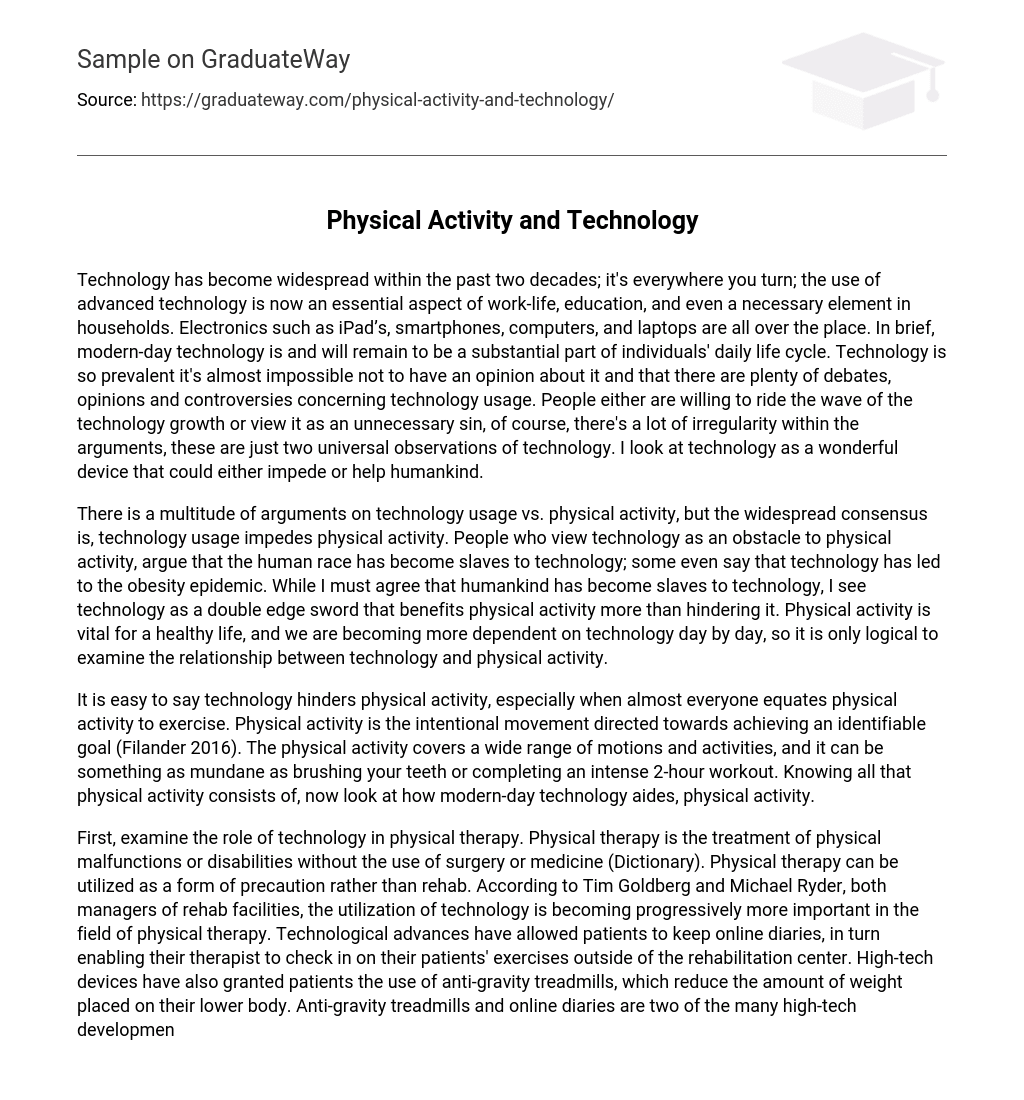Technology has become widespread within the past two decades; it’s everywhere you turn; the use of advanced technology is now an essential aspect of work-life, education, and even a necessary element in households. Electronics such as iPad’s, smartphones, computers, and laptops are all over the place. In brief, modern-day technology is and will remain to be a substantial part of individuals’ daily life cycle. Technology is so prevalent it’s almost impossible not to have an opinion about it and that there are plenty of debates, opinions and controversies concerning technology usage. People either are willing to ride the wave of the technology growth or view it as an unnecessary sin, of course, there’s a lot of irregularity within the arguments, these are just two universal observations of technology. I look at technology as a wonderful device that could either impede or help humankind.
There is a multitude of arguments on technology usage vs. physical activity, but the widespread consensus is, technology usage impedes physical activity. People who view technology as an obstacle to physical activity, argue that the human race has become slaves to technology; some even say that technology has led to the obesity epidemic. While I must agree that humankind has become slaves to technology, I see technology as a double edge sword that benefits physical activity more than hindering it. Physical activity is vital for a healthy life, and we are becoming more dependent on technology day by day, so it is only logical to examine the relationship between technology and physical activity.
It is easy to say technology hinders physical activity, especially when almost everyone equates physical activity to exercise. Physical activity is the intentional movement directed towards achieving an identifiable goal (Filander 2016). The physical activity covers a wide range of motions and activities, and it can be something as mundane as brushing your teeth or completing an intense 2-hour workout. Knowing all that physical activity consists of, now look at how modern-day technology aides, physical activity.
First, examine the role of technology in physical therapy. Physical therapy is the treatment of physical malfunctions or disabilities without the use of surgery or medicine (Dictionary). Physical therapy can be utilized as a form of precaution rather than rehab. According to Tim Goldberg and Michael Ryder, both managers of rehab facilities, the utilization of technology is becoming progressively more important in the field of physical therapy. Technological advances have allowed patients to keep online diaries, in turn enabling their therapist to check in on their patients’ exercises outside of the rehabilitation center. High-tech devices have also granted patients the use of anti-gravity treadmills, which reduce the amount of weight placed on their lower body. Anti-gravity treadmills and online diaries are two of the many high-tech developments that enhance physical therapy. The entire goal of physical therapy is to improve mobility and promote more productive physical activity. As technology progress, so does physical therapy, which will inherently help more people return to normal movement and improve the physicality of society.
Not only has technology aided people in physical activities needed for daily living, but it also has had a tremendous impact on healthy day-to-day exercising. There are now dancing games, YouTube videos, and fitness apps all designed to increase physical activity and promote health; I’m going to focus on apps within this field. First off, fitness apps are mostly free, incredibly convenient, and grant you the liberty of exercising in the privacy of your home. One great example of the many fitness apps available is ‘Daily Workouts’; this app sends prompt reminders of when to exercise and covers a wide range of workout routines. Not only does the app send you reminders of when to exercise it also shows you an example of the exercise routine and allows you to pick a time limit. ‘Daily Workouts’ proved to be very convenient for my work schedule and allowed me to exercise in the privacy of my home. I never developed a workout routine until I downloaded ‘Daily workouts.’ Fitness apps aren’t for everyone, but it creates an avenue for people who have a busy schedule or don’t want to work out in a gym. Yes, there at-home workout DVDs, but why use a DVD when you can download a free app with reminders, and for the most part, phones are always accessible. The use of workout apps and other technologies easily exceeds old workout regimes.
In conclusion, the use of fitness apps, anti-gravity treadmills, online diaries, and a myriad of other technologies have and will continue to promote physical activity. Yes, technology can seriously hinder physical activity, but there’s a considerable amount of benefits that are too large to ignore. Technology is growing with us, and we must use it to the best of our advantage.





